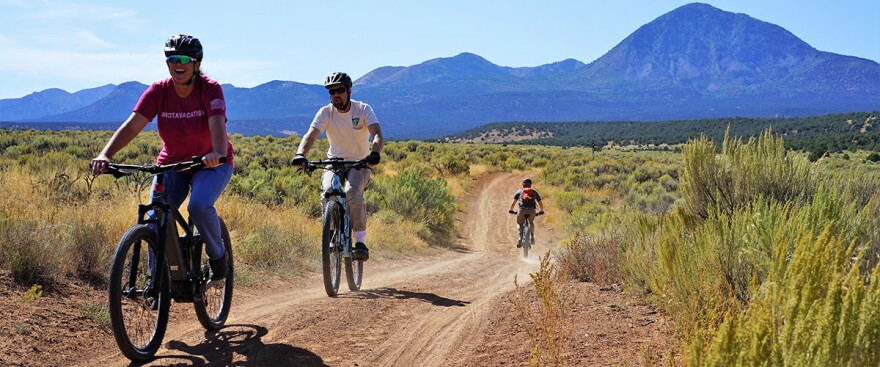If you're anything like me, you've never been on an e-bike before. You might not even know what it looks like. That's why I make a visit to a local bike shop in downtown Laramie to find out what all the fuss is about. Electric bicycles, or e-bikes, as they're known, are having a moment. Right now they're the fastest growing segment of the country's bike market and that market could get even hotter now they're allowed on some public lands.
Pedal House owner and operator Dewey Gallegos gives me a tutorial.
"Here's how it works," he says, and hits a button on a small LED screen on the bike's handlebars. It connects to the motor, which is a long, black box in the middle of the frame. It's a fat bike, too, so it weighs about 55 bikes—that's heavy compared to most bikes. But Gallegos says I won't notice that, thanks to the motor. He shows me the four different modes that you can toggle between.
"First level is eco, that's usually where I start. There's tour as well, sport, and then the zippy little turbo," he says. "Turbo is a lot of fun."
There are three classes of e-bikes, and the differences between them are significant. Here is how it breaks down: A class 1 e-bike requires the rider to be pedaling for the motor to work, and after it hits 20 mph, the motor no longer gives any kind of boost. A class 2 requires no pedaling, and has a throttle. And while the motor of a class 3 e-bike requires pedaling, it will boost the rider up to 28 mph.
The one I take out for a spin in downtown Laramie is a class 1. And it doesn't take long to understand what all the hype is about. It rides like a dream—so light! And way quieter than I expected. It's easy to imagine how much easier it would make my ride to work, especially in the wind or the snow. After about a half hour, I grudgingly return the bike to the Pedal House. There, Dewey Gallegos says he thinks commuting is the best use of e-bikes.
"If you want to get to work, you still want to ride your bike, and you don't want to get sweaty, and you've got over two miles, it's a fantastic option," he explains.
When it comes to allowing e-bikes in wild places though, Gallegos is of two minds. And that's a big question right now. In fact it's at the heart of the debate over the Department of the Interior's recent decision to allow them on public lands.
"I understand it can help a lot of people who wouldn't be out there, get out there. They're not going to come ripping past us, and change the face of recreation in Wyoming," he says.
On the other hand, Gallegos says there are some types of e-bikes he doesn't want to see anywhere near public lands—like a class 2 or 3 e-bike.
But the order signed by the Interior Department back in August doesn't differentiate between the different kinds of e-bikes. All of them will now have the same access to public lands as regular non-motorized bikes.
That concerns Dan Smitherman with The Wilderness Society. He doesn't like any of this. He's also upset about the process that lead to the Interior Department's decision.
"This was an arbitrary top-down rule that didn't have any public input whatsoever and was so done outside the normal trail management process," he says.
Smitherman's non-profit organization along with dozens of conservation and recreation groups have signed an official letter objecting to any attempt to allow e-bikes on non-motorized trails. Smitherman says the agency's decision sets a dangerous precedent, and could open up wild places to all kinds of motorized machines.
"We have non-motorized and motorized trails for a reason," Smitherman says. "The backcountry area or the forest should not be motorized. And an e-bike is not a bicycle, it's a motorized vehicle."
Acting director for the Bureau of Land Management, William Perry Pendley, disagrees.
"Our philosophy is that e-bikes are not off-road vehicles, they are like bicycles," he says. Pendley likens the arrival of e-bikes to when snowboards started showing up on ski slopes.
"At the time, it was almost heresy. 'Why are these people here on these funny looking boards?'" he recalls.
In other words, Pendley says, it's a matter of trail users getting used to something new. Pendley says the big idea behind the e-bike push from the Department of Interior is to get more people out on public lands. And e-bikes do make it easier for people with limitations or disabilities to get out on the trails."The grandparents, instead of sitting in the parking lot, waiting for the kids and the grandkids to get back, could be out there as well," he says.
Pendley is a big proponent of allowing e-bikes on public lands and recently wrote an op-ed on the issue.
While no public comment was gathered before the order came out, it did instruct agencies to submit a timeline for collecting that public input. Pendley says he expects that to open soon.
In the meantime, if you're looking to buy an e-bike it will cost you. The low end comes in around $1,500. Have a question about this story? Contact the reporter, Maggie Mullen, at mmullen5@uwyo.edu.
This story was produced by the Mountain West News Bureau, a collaboration between Wyoming Public Media, Boise State Public Radio in Idaho, KUER in Salt Lake City, KUNR in Nevada, the O'Connor Center for the Rocky Mountain West in Montana, and KRCC and KUNC in Colorado.
Copyright 2020 Wyoming Public Radio. To see more, visit Wyoming Public Radio. 9(MDAwMzY5MzE4MDEzMTE3ODg5NDA4ZjRiNg004))



